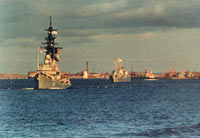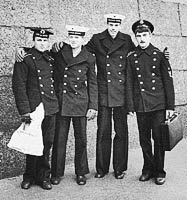| Tell a friend | Print version |
|---|
Memorable Visit
October 13 was a remarkable date – it had been 20 years since the first-ever visit of West German naval ships to the Soviet Union. Previously they paid an official call to Russia in 1912.

West German ships in Leningrad harbor
A short excursion into the past carries inference that the history of relations between two navies is anything but event-saturated. Two years later Russian cruiser Oleg returned a visit to Kiel, and then World War I put paid to naval friendship between Russia and Germany for certain time. To tell the truth, two Soviet warships (Novik-class destroyers named that time as Lenin and Rykov) called at German port Pillau in 1929 (nowadays it called Baltiysk and is main naval base of Baltic Fleet). There the history of friendly contacts dropped.
And finally, after 77 years of standoff and two world wars, the foundation of new relationship between two navies and two states was laid in October 1989 at Leningrad naval base.
Capt 1 rank Vadim GAZIZOV who was a participant of the visit impacts his recollections.
- Vadim Salihyanovich, what was the atmosphere of that visit?
- Speaking military language, the pre-visit situation was "complex and stressful". It shouldn't be forgotten that late 80-ies were the peak of "cold war". In contrast to "land" matters, that was obvious asea.
There were endless exercises in Baltic Sea at that time, conducted by navies of Baltic countries and NATO Navy as well. In mid 80-ies one of four American battleships USS Iowa carried out firing exercise near Bornholm Island. By the way, in addition to mighty huge-caliber gun mounts that ship was armed with cruise missiles. NATO task force was permanently staying in the Baltic, scout ships and recon aircrafts were regularly on watch at our coast.
As a participant of most those days' exercises, I may say that they couldn't go without incidents. What I particularly recall is the case happened during joint Warsaw pact exercise near Kaliningrad in June 1987. German ship Neckar was fired and considerably damaged by Polish shipborne guns, several mariners were severely wounded and transported to Germany by helicopters. In fact, that might cause a response action.
One can fairly say that the opponents have each other on gunsights then. German expression "feindbild" (enemy image) was heard in all spheres of interstate relations. That was also sensible in the military.
However, in late 80-ies when things were going to changes and reduction of tension was felt, such situation had become not only unbearable but unnatural, too. The countries began to make peaceful steps toward each other. In 1988 they signed Agreements of sea incident prevention beyond the territorial waters. In spring 1989 Fleet Admiral B.N. Chernavin, the USSR Navy Commander visited Germany, and in May Admiral Dieter Wellershof, Bundeswehr Inspector General paid return call at Moscow and Leningrad.
Obviously, decisions of radical changes in military relationship were made at these days. Navies were just the basis for peaceful policy in military area. Indeed, guest coming on the tank looks menacingly, while visits of warships are normal in international relations for a long time.
- It is known that there were about 650 sailors called at Leningrad on German ships in Oct 1989. And what the ships they were?
- The ships were destroyer Rommel, frigate Niedersachsen and supply vessel Coburg. Task unit commander was Flotilla Admiral Hans-Rudolph Boehmer. At that time he was destroyers' flotilla commander and afterwards became Inspector of German Navy (Commander-in-Chief). Leningrad naval base headed by Adm. Samoilov represented a host party.
- Nowadays we talk about historic importance of that visit, first in postwar period. But how it was evaluated then, 20 years ago?
- Even at that time the visit was considered as historical event. First, they were NATO ships. Until that time our sailors met only with Polish and GDR mariners being members of Joint Baltic Fleet of Warsaw Pact. Second, they were ships of Germany, the country which considered an initiator of XX century's most murderous war, and many European nations still treated Germany unfriendly then. Third, West German ships visited the city most suffered from fascism during blockade. By the way, talking with German mariners I found out that they were anxious about possible attitude of Leningrad residents.
There were few days remained until fall of the Berlin Wall and one year until the reunion of two Germanies. Nobody supposed then that this union is possible even theoretically, although "wind of change" repeatedly breezed unexpected surprises in our internal and foreign policy. That is why the visit of German ships considered as a sign of future changes in relations between the militaries and countries in whole.
In 1990-ies and later there were series of mutual visits, but that was the first one. You know, the first visit is like a first impression – you can never repeat it.

Vadim GAZIZOV
- So how Leningrad welcomed West German ships?
- It was very hospitable welcome. Apprehension of German sailors was groundless. Certainly, the Germans did their best as well. During the visit they arranged certain "open hours" when anyone could get aboard the ships and there were crowds of people in line started at Harbor Station and stretched away along the Great Marine Boulevard. Sometimes the Germans had to prolong visit terms on hour. They couldn't make visits longer due to ship schedule and preparation to other activities.
The Germans behaved very seriously toward the event and did everything to conduct the visit in the atmosphere of kindness, politeness and attentiveness. They'd prepared memorable souvenirs and gave them out colorfully packed at the staircase. In addition, German cooks baked fresh buns called in German as "pork eyelets" offered to visitors on their route. There were so many comers that I had to use work connections a couple of times to get aboard my friends – naval officers serving in Leningrad that time – by staff staircase.
Punctual Germans calculated that there were 8-8.5 thousands comers per day, i.e. about 35 thousands during the whole visit.
- What else mutual activities were held during the Leningrad visit?
- There were plenty of social calls, meetings, sport events, tours and evening parties. I could tell about them much and long. But there were some events which stick in memory of both parties almost for ever.
What I recall first is German visit of Piskaryovskoe Memorial Cemetery and laying of wreath. Of course, German sailors were aware of the fact that about million Leningrad citizens died during almost three-year fascist's blockade. German guests knew that over half million residents died in blockade and were buried at Piskaryovskoe Memorial Cemetery.
Talking with German officers, it was obvious that they worried much about the attitude of veterans and blockade-sufferers regularly coming to this sacred place.
Laying of wreath was held in unexpected manner. Right after German sailors laid the wreath and Admiral Boehmer made a record in the Book of Remembrance, a crowd of Leningraders came to them. Many of them were crying and wishing it would be no wars at this land as at any other. There were no acts of hostility or aggression.
What I wanted to discover was the everyday life of German mariners beyond participation in official events. That time I couldn't even dream that soon I would manage to visit German ships and submarines of almost all types and classes, meet German sailors and even Bundesmarine Commanders. Until that time I saw West German ships at exercises only from outside, although I had general idea and was familiarized with various information and pictures of them. But there were no opportunity to visit such ship. And finally the first chance to get aboard West German warship was in prospect. It was like a journey to "enemy's den".
As representative of Baltic Fleet Political Department, I applied to the task unit commander with request to visit the ships, talk with the personnel and appoint an accompanying officer for that purpose. Frankly, I thought they would either not allow or exceed the reply for a couple of days.
It is hard to express my surprise when in 15 minutes I was told that Lt. Cmdr Sven Muller-Otte would wait for me at frigate Niedersachsen helipad to accompany me over German ships and answer all questions as early as tomorrow at 9.00 am.

German and Russian sailors had rapidly found common language
Next day we met with Sven at predetermined time and got acquainted. I instantly outlined the range of my interests having said that guns, missiles, torpedoes and helicopters were uninspiring to me. One could read about those matters in a military magazine. What I was interested in was everyday life of the personnel, their service activities and routine. Sven answered it was allowed to inspect everything except no-entry premises like cryptocenter, forbidden to be visited at any warship. Obviously, there were no bans on chatting with sailors.
We walked around Niedersachsen, Rommel and supply vessel Coburg "from keel to acorn" and inspected everything: cook room, mess room, sailors' quarters, cabins of officers and warrants, sick quarters and hospital. Frankly speaking, what impressed me most was spotless surrounding and even a kind of a comfort. That was curious to notice that Niedersachsen had no portholes. It turned out that life support system was provided by internal climating, and all bulkheads and doors were based on the principle of airlock tank. And of course we were greatly surprised meeting chaplains aboard as we lived at an atheistic time. All of them were senior officers and attended every cruise along with crew. Probably, the quiet atmosphere aboard must have been their merit.
It should be noticed that there were no urgent need of interpreters then. Some of mariners spoke a little German or Russian, the rest of them used body language. Anyway, both sides understood each other perfectly and it was usual then to meet people dressed in naval uniform speaking a sort of amazing "language cocktail" at Leningrad streets. By the way, German sailors really managed to walk around the city and even visit homes of Russian colleagues.
Certainly, the most known sights of Leningrad were shown to the Germans during that 4-day call. They visited the Hermitage, the Russian museum, Peterhof and Pushkin. I recall their astonished faces in the Catherine Palace and thoughtful eyes when they saw pictures of the Peterhof taken in 1945. I can only guess what they were thinking about...
And for sure they must bear in mind the soccer game between teams of German visitors and Leningrad naval base. The score was "politically correct" – 3:3.
- Vadim Salihyanovich, what was the main result of that visit on your opinion? Is it still recollected in Germany?
- Of course, no international agreements were signed then, but dynamic companionship helped to thaw the ice of nonconfidence. Right after West German warships visited Leningrad naval base, both political and social contacts between our countries were greatly strengthened; as early as a year later Baltic Fleet destroyer Nastoychivy paid a return call at Kiel. Since early 1990-ies ships of Baltic Fleet have become competent participants of NATO international exercises.
And proving the fact that mentioned visit is still considered historical event in Germany, I'd like to quote a letter of Vice Admiral Boehmer to Admiral V. Egorov, former Baltic Fleet Commander: "This day is a twentieth anniversary of distinct event in the history of our Navies. We were strongly impressed by genuine desire of Russian sailors and Leningraders to build with us new friendly relations for the sake of future. Friendly given hands we could shake and songs we sang together are unforgettable. ...A pathway to friendship started that time goes on. It is a one-way route both in the context of our history and considering our future".
- Thank you, Vadim Salihyanovich. Of course, both states tried to demonstrate their naval mighty, but only to point up again: even the most dangerous weapon is led by humans and they may always find common language.
Source: , Author: Svetlana BELOTSKAYA. Photos are taken from personal files of V. Gazizov. 21.10.09
Translation: RusNavy.com



